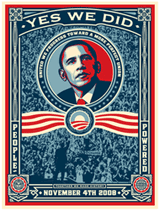One Million Blogs for Peace hasn't listed a Tuesday Topic, so I decided to make my own topic. And I found THIS wonderful list:
“It isn’t enough to talk about peace. One must believe in it.
And it isn’t enough to believe in it. One must work at it.” Eleanor Roosevelt
1. Be a media guerilla. Use e-mail, fax, photocopies, and newsletters to broadcast the message of peace. Spread empowering information.
2. Attend a peace rally. Check out United For Peace & Justice or Peace.Protest.net to find out about marches for peace around the country.
3. Host a peace speaker at an event in your community or at your workplace.
4. Get to know your neighbors. It’s hard to reclaim peace without a sense of community.
5. Make friends with someone of another race, ethnicity, age, ability, or sexual orientation. Appreciating and embracing diversity helps to promote peace.
6. Take an adventure to neighborhoods of your town or country that are ethnically focused to appreciate diverse cultures. Cross-cultural understanding is key to building peace.
7. Travel to learn. Get first-hand experience in how things happen in other places and bring home questions about how you do things at home.
8. Drive with patience and tolerance. Keep the peace on our streets and highways.
9. Listen more. Really listen, without giving unsolicited advice. The validation of being heard is often more important than solving the problem.
10. Learn to say I’m sorry. Learn to mean it. Learn when to say it and use it. These two simple words can prevent violence and save relationships.
11. Be helpful. Random acts of kindness can create more peaceful communities.
12. Spend time with a youngster. This can often remind us of the meaning of a peaceful world.
13. Practice the art of patience. Be careful not to rush to judgment or action.
14. Start peace conversations. Talking peace, and listening, are critical for a vibrant democracy.
15. Involve yourself in community parent workshops and family groups that help parents protect, nurture, and support their children.
16. Peace begins at home. Monitor, nurture, support, and involve your children and family in keeping peace.
17. Explore your prejudices. Find out what’s behind them, how they started, & how they influence your thoughts and actions.
18. Write a peace song. Peace songs are great tools for organizing and inspiring people.
19. Use music, art, stories, and drama to explore themes of peace and nonviolence.
20. Broadcast a peace message using a peace flag, poster, badge, t-shirt, or bumper sticker.
21. If you own a gun, keep it unloaded and locked up. Store the bullets in a separate place and hide the key safely away from children.
22. Find your own inner peace. Set aside a few minutes or more each day of quiet, peaceful time.
23. Join a study circle. Self-education is a fast track to empowerment toward peace.
24. Attend an educational series on non-violence. Look up peace & justice organizations in your state at United For Peace & Justice and call them for information on educational series.
25. Stay tuned to what’s going on in the world through newsletters, periodicals, newspapers, radio, TV, and online.
26. Educate yourself about the violence threatening kids in your community and nationwide. Help bring safety and peace to kids at Children’s Defense Fund and End Abuse.
27. Learn another language. Being able to communicate in a foreign language helps you participate in diverse cultures.
28. Help bring peace to the environment by reducing your carbon load emissions. Learn what you can do at our global warming campaign site at Lick Global Warming (one sweet whirled).
29. Learn how to fight fairly. Fight to resolve differences, not to win.
30. Register people to vote. One reason the political game’s gone sour is that too few of us play. Find out more at Rock The Vote or Project Vote Smart.
31. Become a volunteer on a peace project. Check out Peace Brigades International, Seeds of Peace, and the Peace Corps.
32. Volunteer at your local battered women’s shelter. Learn about the importance of non-violent conflict resolution.
33. Sign-up as a member of a peace organization like Global Exchange, United For Peace & Justice, or Peace Response.
34. Call a radio talk show. The good ones are often the town meetings of the airwaves.
35. Write letters and articles in support of peace and non-violence to the editors of your local media. Published, they can change minds, and even unpublished they can impact the media.
36. Sign a peace pledge.
37. Adopt a politician. Write a monthly letter to your Representative, Senator, or President on peace-related issues.
38. Take social action to support specific legislative peace initiatives. Try the Waging Peace site to get started.
39. Vote. Voting is your hard-earned right and your official voice. For information about the democratic voting process, visit the Federal Election Commission or the Center for Voting and Democracy.
40. Support organizations and/or campaigns that fight for basic human rights for all people. Social justice promotes peace. For a start, visit Global Exchange, or Amnesty International.
41. Run for elective office. Be a voice for non-violent conflict resolution, reasoned sanity, and balance.
42. Learn about nuclear weapons from the Union of Concerned Scientists. Sign an appeal to end the nuclear threat. Visit the Nuclear Threat Reduction Campaign and Waging Peace.
43. Take part in online advocacy for peace. Some good sites to get started are 20/20 Vision and The Interfaith Alliance.
44. Write to your own government; write to a foreign government. Let them know you care about what they do and hold them to the same standards for peaceful conflict resolution.
45. Call your City Council and attend the next meeting. It’s often through the strength of a group that changes are made and community is built.
46. Encourage peace projects for school classrooms. You can find some great ideas at Celebrating Peace and UNESCO.
47. Teach young people skills for non-violent conflict resolution. Learn about some great strategies from the Resolving Conflict Creatively Program or Images & Education for teachers, classrooms, parents, and students.
48. Teach young people about peace. Let your behavior reflect the values you want them to espouse.
49. Support your community’s efforts to create jobs and training opportunities for kids that help them become productive, contributing adults.
50. Dig deep. Oftentimes, reaching peaceful resolution means understanding what’s at the root of a problem rather than what’s most apparent on the surface.
Cross posted at The Katrinacrat
Subscribe to:
Post Comments (Atom)



















12 comments:
I love this post. Peace is possible with just a little effort from everyone. Geeze, I sound like a kindergarten teacher.
Diva,
Thank you so much for taking the time to write this post. I am going to print this off, save it and spread it. Peace, sister.
Absolutely nothing wrong with this list!
Nicely done! ; )
That's a pretty awesome list there DivaJood.
Great ideas. We have to work hard for peace and to save the earth or we're history.
I wish I'd thought of those...very good.
Thank you for this post. These ideas are great.
peace takes a whole lot less effort than planning to harm others--unless of course you are the cheney contingent.
Thanks, Jood...we'll post this.
I was looking for the Bean...where are you sweetie?...we need out Friday fix!
One other item, if I may -
There is a shelter that serves battered women in North and South Dakota called Pretty Bird Woman House. They are a "Light Shining in the Darkness," and they need your help to stay open - they are down to their last few dollars. If you possibly can, please give. (I put a link to "50 Ways" on my blog, and will be adding you to my blogroll :) - oh, and URL is http://prettybirdwomanhouse.chipin.com/pretty-bird-woman-house )
Great list. I think that it's great that The World-Wide-Web has really opened new opportunities for advocacy and other types of campaigns. People have begun to recognized the potential of Internet advocacy as an effective tool for furthering political campaigns.
Post a Comment